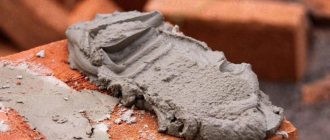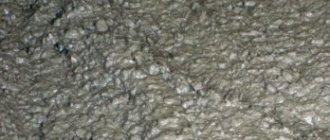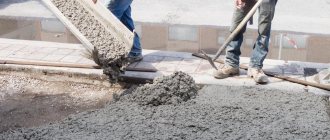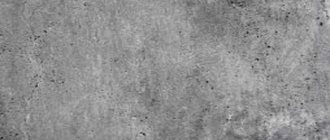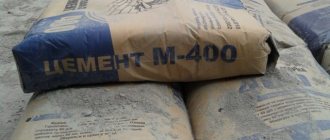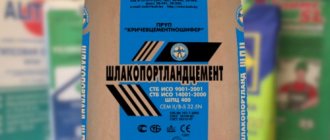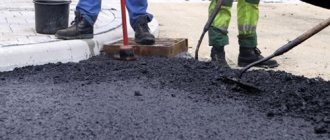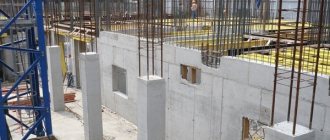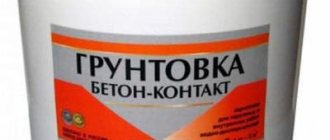- 1 Scope of application
- 2 Features of sand concrete
- 3 Material composition
- 4 Proportions of concrete per m³
- 5 Technical specifications
- 6 Preparation
- 7 Compliance with safety
- 8 Storage
Sand concrete m200 is a universal mixture, widely used for the manufacture of parts of various structures, due to its technical characteristics. The Portland cement included in the composition with additives provides the solution with strength, ductility, frost resistance, water resistance, and resistance to rust.
Types and areas of their use
Universal dry mixtures differ in composition and purpose, they have their own characteristics and characteristics.
You should pay attention to the marking, the number in which indicates the strength of the original product
M100
M100 products are intended for manual plastering and putty. The mixture is applied in an even thin layer, which leads to material savings. She is easy and pleasant to work with. The mixture retains its properties for two hours from the moment of dilution. Prices for M100 products are quite affordable.
M150
M150 products are the most popular of the varieties of universal mixtures. It is used in virtually all construction work using dry compounds. Unlike M300 and M400, it is used for masonry, plaster, and screed. Factory packaging is presented in 50 kg bags, less often they produce products in 25 kg packaging.
The universal mixture includes Portland cement, sand, mineral powder, plasticizers and other additives. The finished composition can only be diluted with cold water in the proportion indicated on the package.
M150 products are endowed with many advantages: they are reliable, frost-resistant, have good adhesion to various surfaces, high moisture resistance and vapor permeability. It is used in any climatic conditions.
The disadvantages of M150 include poor resistance to increased loads (no more than 150 kg per 1 cubic cm), therefore such a mixture is not used for work with the foundations of multi-story buildings.
The name “universal” speaks of the variety of applications of the M150 composition.
- The plaster mixture is designed for interior and exterior plastering work. Layer thickness can be applied up to 50 mm. After mixing, work should begin immediately: the mixture is in a pliable state for 2 hours. The plaster becomes completely dry and strong after 4 weeks.
- Using the M150 screed mixture, the floors in the rooms are leveled. Checking the level and setting the beacons, the floor is poured with a thickness of 1 to 10 cm. Thanks to the cement base, the floor acquires durable qualities that are resistant to temperature changes.
- The masonry mixture is used for laying gas silicate blocks and bricks of all types. M150 products can be used indoors and outdoors in cold or hot weather; weather conditions do not affect the quality of masonry. The dry mixture has proven itself well in rooms with high humidity.
M200
Product M200 is a masonry mixture. It consists of Portland cement, river sand and special additives. Designed for laying bricks, concreting flooring, constructing simple foundations, repairing walls and processing seams in concrete structures.
M200 can be used for laying garden tiles, as well as for plastering and puttying walls. It is available in bags weighing 50 kg.
M300
Sand concrete M300 appeared on the construction market not long ago, but has already gained popularity. Unlike the M150, it is designed for heavy loads. The products are durable and reliable, have a long service life, adapt well to weather conditions, are moisture resistant, environmentally friendly, and do not shrink. M300 consists of Portland cement, which contains gypsum, sand and crushed clinker. Products are packaged in 50 kg bags, less often in 200 kg bags for industrial scale.
Due to its special strength, the composition is used in all areas of construction work in all climatic conditions. During installation, they are used to install the foundation, floor screed, leveling walls and other surfaces. The product has proven itself well as a grout for cracks during work at emergency sites. The composition is used when laying garden paths, stairs, and borders. The mixture is used in the production of expanded clay concrete.
According to their properties, depending on the application, M300 products are divided into several subtypes.
- Coarse grain has incredible strength and long service life. With its help you can fill the foundations of high-rise buildings.
- Medium-grain is used for screeds, self-leveling floors, work with borders and garden paths. It is used wherever a medium-grained fraction of the mixture is required.
- Fine-grained is also reliable and durable; it is used for plastering work.
When choosing a universal dry composition, you should remember: the more famous the brand and the higher the grade of the product, the more expensive the product and the more reliable its technical properties.
For information on what dry building mixtures are, see the following video.
Concrete designations and areas of application
In order to divide concrete into types, alphanumeric designations are used. The first letter is “M”, followed by a number indicating the degree of concrete’s resistance to compression at the time of complete hardening (approximately a month). For example, M400, in this case the resistance is 400 kg/ms 2. This means that the larger the digital designation, the more durable the concrete is.
For each type of construction work, a specific grade of concrete is used:
- grades from M100 to M150 are used for pouring under the foundation;
- M200 is the most common option; foundations, floor screeds, retaining walls and roads are poured with this brand;
- M350 is used as a fill for foundations for large structures, as well as for road decks.
- grades with higher performance are already used in the construction of more complex and heavy structures, such as various hydraulic structures, dams and dikes; they are not used in everyday life.
Specifications
The technical characteristics of sand concrete determine the rules of its operation and resistance to external destructive factors. The composition and technical properties of the M300 mixture make it possible to use it both as a self-leveling compound (self-leveling mixture) and as a repair composition.
Compound
Any variants of M300 mixtures are gray in color. Its shades may vary depending on the composition. For such materials, Portland cement M500 is used. In addition, the M300 mixture, according to GOST, has the following proportions of the main components: one third of cement, which is the binding ingredient, and two thirds of sand, which is the filler.
Frost resistance
This indicator indicates the ability of the material to withstand multiple temperature changes, alternating thawing and freezing without severe destruction and reduction in strength. Frost resistance allows the use of M300 sand concrete in unheated places (for example, in permanent garages).
Frost resistance of mixtures with special additives can be up to 400 cycles. Frost-resistant repair mixtures (MRMs) are used for mixing construction compounds used in the reconstruction and restoration of concrete, reinforced concrete, stone and other joints, filling voids, cracks, anchors and for other purposes.
Compressive strength
This indicator helps to understand what tensile strength a material has under static or dynamic influence on it. Exceeding this indicator has a detrimental effect on the material and leads to its deformation.
Dry mixture M300 can withstand compressive strength up to 30 MPa. In other words, given that 1 MPa is approximately 10 kg/cm2, the compressive strength of M300 is equal to 300 kg/cm2.
Temperature range
If the thermal conditions are observed at the time of work, the process technology is not disrupted. The continued preservation of all the performance qualities of concrete is also guaranteed.
It is recommended to carry out work with M300 sand concrete at temperatures from +5 to +25? C. However, sometimes builders are forced to violate these recommendations.
Adhesion
This indicator characterizes the ability of layers and materials to interact with each other. Sand concrete M300 is capable of forming reliable adhesion to the base layer, which is equal to 4 kg/cm2. This is a very good value for dry construction mixtures. To ensure maximum adhesive performance, manufacturers provide appropriate recommendations regarding preliminary preparation work.
Bulk density
This indicator means the density of the material in its uncompacted form, taking into account not only the volume of particles, but also the space that has arisen between them. This value is often used to calculate other parameters. In bags, the M300 dry mixture is in bulk with a density of 1500 kg/m3.
If we take this value into account, it is possible to draw up an optimal ratio for construction. For example, with the declared density, 1 ton of material is 0.67 m3 in volume
In small-scale construction work, a 10-liter bucket with a volume of 0.01 m3 and containing about 15 kg of dry mixture is used as a measure of the amount of material.
Sand particle size
Factories produce M300 sand concrete using sand of different fractions. These differences determine the peculiarities of the technique for working with the solution.
There are three main sizes of sand used as raw material for dry mixtures.
- Small size (up to 2.0 mm) – suitable for street plastering work, leveling seams.
- Medium size (from 0 to 2.2 mm) – used for screeds, tiles and borders.
- Large size (more than 2.2 mm) – used for pouring foundations and foundations.
Mixture consumption
This indicator characterizes the material consumption with a layer thickness of 10 mm per 1 m2. For M300 sand concrete it is usually in the range from 17 to 30 kg per m2. It is worth noting that the lower the consumption, the more economical the work costs will be. In addition, manufacturers often indicate the consumption of sand concrete in m3. In this case, its value will vary from 1.5 to 1.7 t/m3.
Delamination
This indicator characterizes the connection between the lower and upper parts of the solution. The M300 mixture usually has a delamination rate of no more than 5%. This value fully complies with the requirements of the standards.
How to calculate the need for sand concrete
Knowing the amount of sand concrete per square meter of surface or one cube of masonry, it is easy to calculate the need for the material:
- when calculating the need for screed, you should multiply the area of the room by the consumption rate of sand concrete;
- When determining the volume of dry mixture for pouring the foundation, multiply the volume of the foundation by the material consumption.
The introduction of fine crushed stone or gravel into the composition of the dry mixture allows you to reduce its consumption. When performing calculations, take into account the thickness of the sand concrete layer.
What is sand concrete made of?
The characteristics of sand concrete m300 (composition, proportions 1 m³) are standardized by GOST 7473-94.
High-quality dry mixture contains:
- Portland cement PC500 D20/PTs400 D0;
- fractionated dry sand, with a combined composition of fractions (particle size 0.80-4.0 mm);
- other additives (frost-resistant, microsilica, fiberglass) are introduced at the discretion of the manufacturer.
Sand concrete M300 can be used to construct wear-resistant, high-strength floors as a load-bearing covering in utility and residential premises, including garages, basements (with a load of 250-300 kg/cm²)
Depending on the sand used, M300 grade material is used to carry out certain work:
| Sand, particle size, mm | Characteristic | Application |
| Small – 0.80-1.20 | High wear resistance and strength characteristics | Carrying out critical masonry and other external work, light floor screed 50.0 mm, installation solutions of increased strength |
| Average – 1.80-2.20 | Increased resistance to operating loads | Implementation of interior work, laying curbs, paving slabs, erection of Euro fences, screed up to 100 mm, “warm floor” systems |
| Large – 2.50-4.0 | Moderate moisture absorption | Construction of slab, strip and column foundations, plinths, pit floors, without restrictions on thickness using reinforcement |
Use for building foundation
If it is impossible to purchase heavy grade concrete, or in the construction of low-rise buildings, use a proven building material - sand concrete. Foundation foundations require an increased margin of safety, increased mixture density and resistance to negative temperatures.
For the construction of foundations, a mixture with increased strength characteristics is used
Sand concrete M300 meets the specified criteria and is used to solve the following problems:
- construction of strip foundations;
- construction of monolithic prefabricated foundations;
- concreting monolithic foundations of buildings.
Thorough compaction of the dry mixture reduces the likelihood of cracking of the massif and the formation of internal cavities. When planning the need for building materials, keep in mind that 1 cubic meter of ready-made mortar will require 0.75 tons of dry sand concrete.
Composition of sand concrete m200
The composition of sand concrete is determined by GOST 31357 - 2007 “Dry mixtures for construction with a cement binder”. Each manufacturer can make small additions to the composition of the mixture, but there are key components and indicators that are standard.
Main components:
- Cement m400;
- Sand;
- Crushed stone;
- Water.
When creating, Portland cement M400 is mainly used; it is one of the most common, and its technical characteristics meet all specified standards. Sand is used in two types of fractions - fine-grained and coarse-grained, thoroughly cleaned of foreign impurities.
The composition and proportions of sand concrete m200 per 1m3 according to construction standards, the mixture consumption is:
- Portland cement - 265 (1 part);
- sand 860 (2 parts);
- crushed stone 1050 (5 parts);
- water 180 (? parts).
Preparing the base for laying sand concrete
The following types of bases are used as the basis for pouring sand concrete composition:
- stone;
- brick;
- concrete;
- cement.
The preparation process involves the following operations:
- removing oil stains;
- mold removal;
- elimination of surface contamination.
To increase the adhesion of sand concrete to the base, it is important to carefully prepare the surface.
The working mixture can be used as either a base or a binder material.
Tips and tricks
When planning to prepare a cement-sand mixture, you must immediately decide in what proportion the different components will be taken, what grade of strength is needed, and what the main properties are.
It all depends on the scope of application of the mortar - so, if M50 or M75 is suitable for brickwork, then for screed prepare at least a mixture of M150, 200 and higher. The composition of any CPS includes cement, sand, water, but the result is different depending on the ratio.
Some tips from the experts:
- To prepare a plastic mixture, you can add liquid soap to the solution, previously thoroughly mixed with water.
- You need to know how to properly dilute cement and other components: first, all the dry substances are mixed, then water is added in small portions so that you can control the thickness of the mixture and achieve the ideal consistency.
- When preparing, take into account the brand of building material from which the walls are built. It is desirable that the parameters coincide - then the wall will have a homogeneous structure, reliable and durable.
- Before you make your own cement for plaster, you should take care of purchasing perlite. If you replace some of the sand with it, you will be able to achieve higher thermal insulation characteristics.
- For work, we use exclusively fresh cement, without lumps, produced according to technology and stored in optimal conditions - in this case, it will be possible to achieve the most uniform mixing and high adhesion.
- Detergent or soap is also added to the cement (the proportions remain the same, it is simply mixed with mixing water) to increase adhesion.
- The solution is best prepared in a container made of metal, plastic or wood.
- To thoroughly clean the sand from impurities that can reduce its strength, you can soak it in water for a short time.
- The consistency of the finished cement-sand mixture is usually checked with a trowel: the solution should be distributed evenly over the tool, but not run off (it is worth remembering that this rule works in the preparation of standard mixtures; for some tasks other properties may be important).
- The finished DSP is used for an hour after mixing, until the solution begins to thicken and harden. Therefore, you need to immediately prepare the required volume - exactly as much as you can produce in an hour.
- It is forbidden to dilute an already hardened solution with water, as it immediately loses its properties and can cause destruction of the structure/building.
- When mixing a mixture in a volume greater than 2 cubic meters, no drills or attachments will help - only a concrete mixer or ordering the required volume at the factory.
- The solution, which is planned to be used where minimal loads and low mass are noted, can be prepared with a reduced volume of sand. But this approach is only possible on the condition that before properly mixing the DSP, the master has precisely determined the specifics of the application and the remaining solution will not be used for the implementation of any other tasks.
- Mixing the cement-sand mass should last at least 20 minutes - this way the solution will be homogeneous and of high quality.
- The ratio of the proportions of the components is looked at in GOSTs and SNiPs (the opinion of experienced craftsmen is allowed), as well as in the recommendations of the manufacturer of cement, dry mix, etc.
Cement-sand mixture is a universal material that can be used to perform a whole range of works, obtaining the most durable and strong structures. Provided you select high-quality materials and follow the technology for preparing the mixture for the task at hand, everything can be accomplished quickly and easily.
Proportions of concrete for the foundation in buckets
When doing work with your own hands at home, the correct proportions are most often measured in buckets - this is what every summer resident has in use. This allows you to mix concrete quickly enough without sacrificing quality. In accordance with the requirements of a specific foundation, the composition of the components of the concrete mixture is selected, i.e. their proportions in buckets.
Keep in mind that each component of the mixture has a different weight: cement together with a bucket weighs about 15 kg, sand - 19 kg, and crushed stone - about 17.5 kg.
Advice! Use small crushed stone, the fraction of which is not higher than 2mm.
To obtain 1 cube of concrete, the proportion should be 2/5/9, where 2 is cement, 5 is sand, and 9 is crushed stone.
The most optimal solution would be to prepare M200 mortar, which is excellent for pouring a foundation or floor screed. Typically, the volume of water added to the composition corresponds to half the volume of cement.
The composition should be prepared before starting concreting work, and the process itself should take about two hours, otherwise it may begin to harden.
If you want to build a structure on a frame, a columnar foundation is suitable, which does not require the preparation of a strong mixture.
You can measure materials in buckets if you have a small amount of work to do and if the foundation will be poured in stages.
Peculiarities
Dry mix M-300 is a ready-made masonry mixture, the components of which are selected in the required proportions. Before use, the composition is diluted with water in the volume specified by the manufacturer and mixed mechanically until smooth.
The mixture is sand concrete, since it is based on purified fine-grained concrete and Portland cement. The dimensions of the first do not exceed 3 mm; the Portland cement used has a grade strength of M-400 or M-500). To ensure certain characteristics (frost resistance, moisture strength, and so on), plasticizers are introduced.
Various reinforcing fibers may be present in compositions operated at subzero temperatures. To improve adhesion, a special type of clay, coarse sand, or granite chips are sometimes added.
Unlike conventional concrete mortars, M-300 sand concrete is distinguished by its ease of preparation, plasticity (suitable for laying in a thin layer, which is necessary for certain types of masonry), high strength, and economical consumption. The M300 mixture is a masonry mixture, that is, it is used for fixing bricks or masonry stones. In addition, it can be used as a concrete mixture for casting.
The composition is characterized by non-shrinkage, which allows it to be used as a floor screed. And thanks to its increased strength and wear resistance, the mixture is used even when organizing high-strength floors. The thixotropy of the composition allows it to be used also for leveling floors, as well as sealing cracks in concrete surfaces.
The material is suitable for both private housing construction and the construction of industrial and administrative facilities, as well as the installation of basements and garages. It is used when pouring the foundation, including in places where concrete and reinforcing sections meet. The mixture is also used to create paths in private suburban areas. In its properties, the material resembles fine-grained concrete, therefore it is used both outside and indoors.
Proportions of components for preparing 1 cubic meter. concrete
Foundation concrete has several grades, which are determined by the type of future structure, its weight and purpose. To prepare each brand of concrete, a specific brand of cement can be used. In general, these two factors determine the number of components required to prepare one cubic meter of concrete.
In most cases, concrete grade M 200 is used for the construction of foundations; it has sufficient strength and can withstand freezing and thawing many times. To make such a solution, M500 grade cement, medium-fraction crushed stone and water from the water supply are used.
To prepare one cubic meter of M200 concrete, you need to take the following number of components:
Read also: Do-it-yourself press from a jack, drawings, dimensions
- Cement – 300-350 kg.
- Crushed stone – 1100-1200 kg.
- Sand – 600-700 kg.
- Water – 150-180 l.
To convert the indicated values into volume in buckets for more convenient measurement, it is enough to know the approximate mass of each component in one bucket. For example, a 10 liter bucket holds 15.6 kg of cement, 19.5 kg of sand and 17 kg of fine crushed stone. Therefore, to mix a concrete mass with a volume of 1 m 3 you will need approximately 20 buckets of cement, 30 buckets of sand, about 70 buckets of crushed stone and 15-20 buckets of water. As you can see, calculating the proportions of concrete for the foundation in buckets is not so difficult.
General information
A characteristic feature of concrete is its composition, as well as proportions and preparation technology. It consists of cement, fine and coarse fillers, water and various additives. In addition, there are brands of concrete that do not contain coarse filler. There are different mixtures that are used for specific cases and also have different properties.
Designation and its interpretation
Concrete structures gain full strength within 6 months, and in 30 days concrete gains 70% strength. M300 is used in all structures that are subject to significant load, therefore, one of the main indicators is its strength. The MXXX designation template does not indicate a specific brand, but is an indicator of the maximum compression pressure.
In addition, there are other designation patterns, for example, FXXX and WXXX, indicating frost resistance and water resistance, respectively. The M300 class of concrete shows the totality of all grades whose ultimate strength is 300 kgf/sq.m. cm. The tensile strength is tested in laboratory conditions by applying force to parallel planes of a product cast from concrete, in the shape of a cube with a side of 150 mm. The grade of concrete in terms of strength is correlated with its class. These indicators should be selected for the construction and calculation of the finished structure at the maximum load that it can withstand.
M300 corresponds to class B22.5 with a coefficient of variation (CV) that is 13.5%. It shows the homogeneity of the mixture from which any brand of concrete is made. When this coefficient changes, the grade of concrete will also change, that is, if its value is low, the grade will increase and vice versa. If the concrete is M300, then with different values of the coefficient its class will change:
- At Kv = 5% the class is B25.
- At Kv = 13.5% - B22.5.
- At Kv = 18% - B15.
Main characteristics
Concrete is classified into grades, and this distribution is primarily related to the parameters of strength (B), density (D), water resistance (W), frost resistance (F) and workability (P). One of the best options for most construction work is M300 concrete, the characteristics of which are as follows:
- Strength: B22.5 with an indicator of 295 kg/sq. cm.
- Specific gravity of concrete M300: 1800−2500 kg/cubic. m.
- Water resistance: W6-W8.
- Frost resistance: F200-F300.
- Mobility: P2-P4.
The strength indicator is the main characteristic and shows the maximum effect of forces during compression, at which the structure collapses. The specific gravity or density of M300 concrete depends on the type of coarse filler included in its composition. When using limestone, the D value is about 1800 kg/m3. m., and when using harder rocks (crushed granite, granodirite, etc.) it can reach a value of 2500 kg/cubic. m. Due to its high density, this type is classified as heavy. The density indicator depends on the presence of violations in the manufacturing technology and air cavities.
Water resistance (WXX) is a value indicating the water pressure in MPa to pass through 0.15 m of concrete. For concrete grade M300, this indicator is equal to W5-W6; at a pressure of 0.5-0.6 MPa (approximately corresponding to 5-6 atmospheres) it does not allow water to pass through at all. By adding hydrophobic cement, additives and carefully compacting the solution, it is possible to increase the waterproof rating.
Frost resistance is indicated in the form of the FXXX pattern and shows the number of defrost-freeze cycles without loss of strength. This characteristic can be increased in several ways:
- The use of additives that prevent the formation of air bubbles.
- Removing air from the concrete mixture using vibrators, as well as using various compactors.
- Reducing the amount of water (impairs mobility).
- Using solid fillers instead of crushed limestone.
Application in construction
Since M300 has good strength, frost resistance, water resistance and mobility, it is widely used in construction. In addition, its main indicators can be adjusted by changing the components included in the concrete mixture. It is advisable to use it for the following work:
- Construction of platforms, roads and curbs.
- Installation of walls and various supports.
- Construction of stairs, landings and pouring of foundations in multi-storey buildings.
- Production of reinforced concrete products and fences.
- Production of sewer pipes that are constantly exposed to moisture.
- Construction of objects that are affected by constant temperature changes.
Online calculator
To calculate the proportions of the concrete mixture, use the online calculator.
Read also: Metal with the highest thermal conductivity
Some people prefer to do this with a shovel, but this tool does not provide sufficient efficiency, which affects the quality of the result.
If you still have no choice, then you can use the equipment described above, but make sure that it is absolutely dry, like the kneading bucket. All materials are measured using buckets, and then compacted well and leveled with a shovel. To make it convenient to work with the mixture, you will need a capacious container. We mix sand and crushed stone, make irregularities on the surface of the mass, into which we pour cement. Mix all components thoroughly until a homogeneous consistency is obtained.
Work on pouring the foundation should be carried out in the warm season so that it does not begin to freeze, and the resulting ice crystals do not begin to destroy it from the inside.
Thus, we have considered the proportions and composition of concrete, as you can see, everything is quite simple. It is only important to take into account some subtleties and have some dexterity when kneading. Carefully study the composition of the materials you buy and their properties, then you will be pleased with the result. Even if you miss something somewhere and end up with concrete of a lower grade than you planned, it will be quite suitable for installing a foundation for a house or gazebo.
[content-egg module=AdmitadProducts template=price_tracker_alert]
Proportions of concrete in buckets
Every building, regardless of its purpose, needs a strong support; the reliability of the building and its durability depend on its quality. The foundation can have different shapes and consist of different materials. However, in any case, the main component of the foundation is concrete.
How to prepare TsPS?
Each ready-made mixture must be accompanied by instructions on the required amount of water; other components are usually not provided. When used as part of additional materials (dyes, reinforcing fibers), the proportions must be observed strictly in accordance with the instructions for the additive. The typical ratio of mixture to water is 5 to 1 (a bucket of water per 50 kg bag of mixture), the share of dyes is 0.1%, the share of fiber fiber is 1%.
When making it yourself, the proportions of water and sand to cement are taken depending on the type of work being carried out, strength requirements, and the degree of moisture content of the sand:
1. The thickest mortar required for masonry is the water/cement ratio of no more than 0.8.
2. For screed and plaster, sour cream-like compositions with a W/C ratio of 0.8–1.2 are used.
3. When spraying and grouting, dilute the solution even more, up to W/C - 1.5.
4. Mixtures with W/C less than 0.6 are used when it is necessary to obtain a quick-drying high-grade cement-sand mortar (M300 and higher), or for concrete.
If a concrete mixer is used for mixing, it is recommended to carry out the work in the following order:
- Pour water into the untwisted drum and add additives.
- Add 2 buckets of sand.
- Add a bucket of cement and wait for it to mix.
- Add the remaining sand and add water if necessary.
When kneading by hand, water is poured into the dry mixture. If you do the opposite, water forms a film of cement on the surface of small lumps of the mixture, which will slow down the process many times over. If the composition is made from its own components, it is advisable to mix them dry before adding water.
Once prepared, the solution must be used before it begins to harden - from 15 minutes to several hours, depending on the use of additives, cement concentration and temperature. The usual solution M150-M200 at a temperature of 20 ° C begins to harden an hour after mixing.
Consumption
To plan the mass of the CPS in advance, you need to approximately calculate the required volume of solution and multiply it by the cost per 1 m3 indicated in the description of the mixture. Most often they are indicated in the format “mixture consumption per m2”, meaning a layer 1 cm thick. To get the costs per 1 m3, just multiply the indicated value by 100.
The usual consumption values for sand-cement mixture are 1800 kg/m3, for high-quality compositions - up to 2200 kg/m3, for lightweight plasters with lime - 1200-1600 kg/m3.
Calculating the volume of consumption of mortar for plastering work and screed is not particularly difficult, but the cost of material for masonry depends on the skill of the particular performer. If you strictly follow the technology, the solution consumption will be 25% of the total volume of the wall, but in practice this value can be either up to 35% (thick seams, losses due to splashes) or below 20% (waste masonry, use of poor-quality techniques to speed up work ).
Preparation
Maintaining a clear procedure for preparing the solution will help to obtain the desired result that meets the standards:
- The dry mixture is added to cool water, and not vice versa.
- Thoroughly stir the solution until smooth, using a drill with an attachment.
- Allow the solution to settle for 5 minutes and mix again.
- The first setting of the mixture is visible after two hours, but the required strength will be achieved no earlier than after 28 days.
- A clean work surface and an air temperature of at least five degrees Celsius will help to avoid cracks.
Return to contents
Peculiarities
Cement mortars with sand are used to perform a wide variety of work during the construction, finishing, and renovation of buildings. It’s not difficult to make a mixture with your own hands, but you need to know the exact proportions of cement, sand and water. The easiest way to mix is to use a concrete mixer, renting or purchasing one.
Before making a solution of cement and sand, it is necessary to decide on the scope of application, since the proportions differ within significant limits. The most popular is considered to be DSP for brickwork: cement-sand mortar is used to create load-bearing walls, and with the addition of lime for internal walls.
The composition of the cement mortar largely depends on the working conditions and operation. If work is carried out in frosty conditions, then special anti-freeze additives are added to the composition to prevent the CPS from freezing. But they are suitable for working in frosts below -20 degrees (it’s better not to do anything at all, but to wait for warmer weather), since they will not be flexible and flexible enough.
If a cement solution is prepared for use in monolithic hearths with an open fire source, in the construction of a furnace or firebox, then heat-resistant fire-resistant mixtures are created: from cement of at least M400 grade, with crushed brick, fine fireclay sand.
For each type of task and working conditions, a solution is prepared from basic materials, but in different proportions and with the addition of additives and plasticizers. As a rule, additives change one parameter - this could be the rate of hardening, mobility, frost resistance, etc. Each master determines priority tasks and performs calculations before preparing the cement mortar.
Where is it used?
The material is very convenient to work with when screeding heated floors.
Experienced builders prefer IVSIL M200 and Hercules. The properties of these solutions, especially minimal shrinkage and hardening speed, allow them to be used in the following projects:
- laying building stone;
- concreting structures;
- closing cracks and potholes;
- pouring the base;
- surface leveling;
- underfloor heating screed;
- monolithic construction of walls;
- arrangement of the local area;
- formation of garden paths.
Scope of use of dry assembly and masonry mixture M200
The building material is most widely used when constructing screeds for various types of heated floors. It is also suitable for leveling ceiling, wall surfaces, and floors.
Assembly and masonry mixture M200
recommended for:
- concreting paths, individual elements of objects, stairs, supports;
- grouting working joints between concrete blocks, slabs;
- lining of external walls, if waterproofing is not required;
- installation of reinforced concrete structures (anchoring of individual elements);
- laying concrete blocks, bricks or other building materials.
Installation and masonry work with dry mix M200
can be carried out using materials of any format.
Storage and transportation
PB is packaged by the manufacturer in multilayer paper bags with a filling of 25 or 40 kg. Although this container is quite durable, cargo preservation measures must be observed during transportation. Transportation by road will be cheaper.
It is important to lay the bags correctly and protect them from precipitation. You can also purchase sand concrete with delivery.
In practice, the quality of the mixture decreases with each month of storage, so it is more rational to purchase a recently produced mixture before using it.
Shelf life in dry warehouses is 6 months (in some cases up to a year). In damp rooms, despite the impregnated protective outer paper shell, PB cannot be stored. For storage, pallets are used that separate the bags from the floor.
Plastering technology
- Before plastering, de-energize the wiring and prepare the base. This is a mandatory first stage of any plastering work.
- Then a leveling solution is prepared (for each leveling layer the solution is prepared separately).
- The third stage is plastering.
- Caring for the applied solution during its hardening.
The process technology is described on the packaging. It is necessary to comply with the conditions under which the walls are plastered. For example, for “winter” mixtures, the manufacturer indicates the temperature of water and air. Indoor work is usually carried out at a temperature of +5-+25°C.
If plastering is done with sand concrete, you need to get used to it, since the mixture, being related to cement-sand plaster, has its own characteristics. For example, you cannot apply the solution in a layer of more than 6-7 mm, since the heavy mass will slide down under the influence of weight.
In cases where the layer needs to be made thicker and plastering must be speeded up, the base is reinforced with mesh so that it is located inside the layer of plaster mass. The mesh fabric is attached to the wall so that it does not sag.
Preparing walls for plastering
Preparatory work can be divided into categories:
- for cosmetic repairs;
- for major repairs;
- in a new building.
In all cases, as a result of preparatory work, the surface must be cleaned of grease, rust, and mold stains.
In a new building with smooth walls, the surface of the base is covered with notches to increase adhesion.
In brickwork, for the same purpose, the seams are embroidered to a depth of 1 cm, and the top of the bricks are scratched with metal brushes. Excess hardware is removed from the walls, the remaining ones are isolated, for example, by painting with oil paint. Cleaned surfaces are dusted and primed.
In case of repair, remove fragile finishing (wallpaper, plaster, paint, as well as loose plaster). Repairs chips and large cracks. Then the dust is swept away, primed, and dried.
Weak bases are strengthened with reinforcement, impregnations, and deep penetration primers.
After priming, beacon profiles are installed (if plastering is carried out along beacons).
Preparation of the solution
Leveling plastering is performed in layers (the solution for each layer is prepared separately and has a different consistency). Therefore, it is important to correctly calculate the amount of solution so that it is enough to apply a layer and does not leave a large amount of excess.
The mixture is kneaded manually (with a mixer) or in a mortar mixer, adding powder to water. In both cases, the mixture should be homogeneous. 2 minutes of mixing in a mortar mixer is sufficient. Before use, the solution is allowed to infuse for 5-10 minutes.
How to plaster with sand concrete
Leveling plaster with sand concrete is applied in the following sequence:
- The spray layer is made with a solution that has the consistency of kefir. The wall is moistened before application, the dough is spread with a trowel, ladle or applied using a grater. The layer is not leveled, since its purpose is to create a buffer adhesive zone. Thickness – 5-6 mm. Do not allow the layer to dry! As soon as the “kefir” begins to matte (become matte), they move on to the next stage.
- The main leveling layer (soil) is made with a thicker solution. This layer is applied by spreading it with a grater after moistening the previous one. The surface is leveled according to the rule. You may have to make two layers of soil. In any case, the applied mass is not allowed to dry, since cement requires wet conditions to gain strength. After application, the wall is covered with damp matting or film to protect moisture. When the solution begins to set, the beacons are removed and the grooves are filled with soil.
- To create the third layer, it is allowed to use polymer decorative plasters or a cement coating to obtain a smooth surface. The third layer can be a solution with fine sifted sand with the consistency of kefir. In the case of finishing tiling, this layer is not needed.
